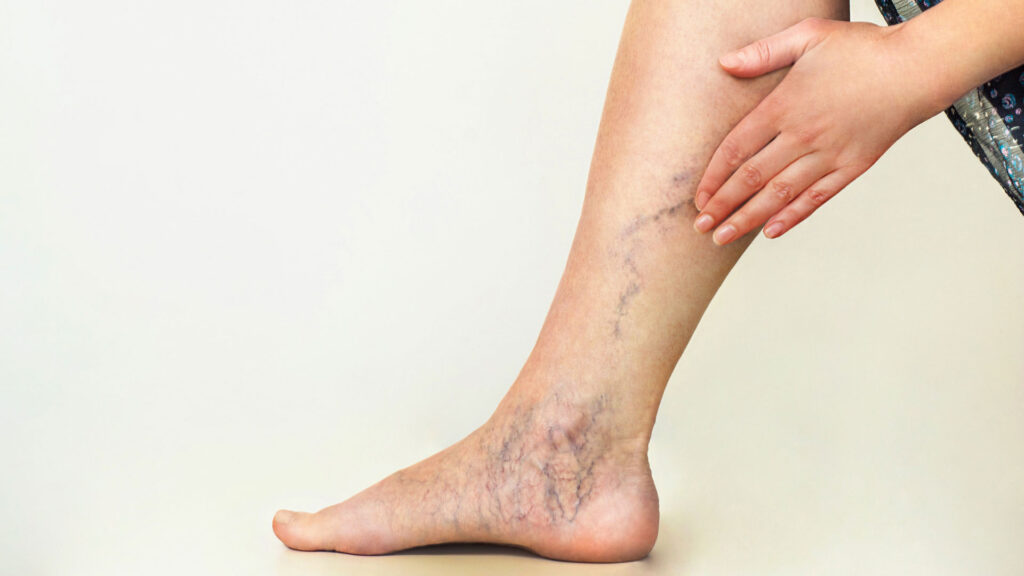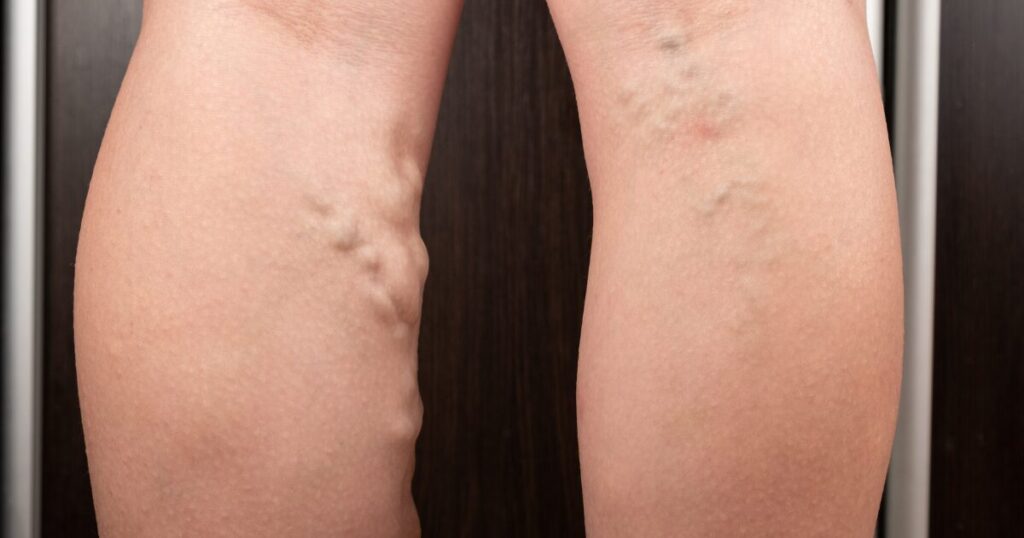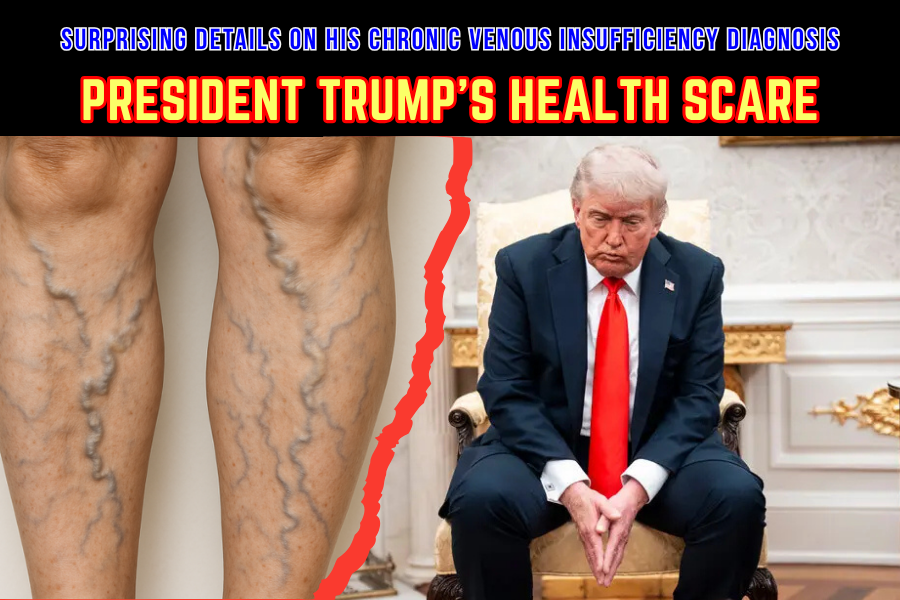(By Mohsin Tanveer)
Introduction
On July 17, 2025, a bombshell White House announcement revealed that President Donald Trump, aged 79, was diagnosed with chronic venous insufficiency (CVI), sparking widespread curiosity about his health. Described as a “surprising health scare” after photos showed swollen ankles during high-profile events, this common yet intriguing condition has raised questions: What is CVI? Could it impact Trump’s presidency? This article dives into the surprising details of CVI, its effects on the oldest president ever inaugurated, and how he can manage this condition while leading the nation.
What is Chronic Venous Insufficiency?
Chronic venous insufficiency is a medical condition where the veins in the legs struggle to return blood to the heart due to weakened or damaged valves. Normally, one-way valves in the leg veins ensure blood flows upward against gravity toward the heart. When these valves malfunction, blood can flow backward (venous reflux) and pool in the lower limbs, leading to increased pressure in the veins. This can cause swelling, discomfort, and other symptoms. CVI is often a progressive condition, meaning it may worsen over time if untreated, but it is not typically life-threatening.

Causes and Risk Factors
CVI develops due to several factors, including:
- Age: The risk increases with age, particularly after 50, as veins and valves naturally weaken.
- Genetics: A family history of CVI or varicose veins heightens the risk.
- Obesity: Excess weight puts additional pressure on leg veins.
- Prolonged Standing or Sitting: Jobs or lifestyles involving extended periods of immobility can impair venous return.
- Previous Blood Clots: A history of deep vein thrombosis (DVT) can damage vein valves, leading to CVI.
- Pregnancy: Hormonal changes and increased blood volume can weaken vein walls.
- Inactivity or Smoking: These contribute to poor circulation and vein health.
CVI affects approximately 5–40% of U.S. adults, with higher prevalence in older populations, making it a common condition. Women are at a slightly higher risk (about 2:1) due to hormonal influences and pregnancy.
Symptoms of Chronic Venous Insufficiency
CVI manifests through a range of symptoms, primarily affecting the legs:
- Swelling (Edema): Most commonly in the ankles and lower legs, as seen in President Trump’s case.
- Aching or Heaviness: Legs may feel tired, heavy, or achy, especially after prolonged standing.
- Varicose Veins: Swollen, twisted veins visible under the skin.
- Skin Changes: Discoloration (reddish-brown or leathery appearance), itchiness, or thickened skin.
- Cramping or Tingling: Nighttime cramps or a pins-and-needles sensation.
- Venous Ulcers: In severe cases, slow-healing sores may develop, particularly around the ankles.
These symptoms can vary in intensity, and in President Trump’s case, the White House reported only “mild swelling” with no discomfort, suggesting an early-stage diagnosis.

Diagnosis
Diagnosing CVI requires a thorough medical evaluation to rule out more serious conditions like DVT, heart failure, or kidney disease, which can also cause leg swelling. In President Trump’s case, diagnostic tests included:
- Venous Doppler Ultrasound: A non-invasive imaging technique to assess blood flow and vein structure, confirming CVI.
- Blood Tests and Echocardiogram: These ruled out systemic issues like heart or kidney dysfunction.
The White House confirmed no evidence of DVT, arterial disease, or other serious conditions, indicating that Trump’s CVI is an isolated, benign issue.
Prevalence and Commonality
CVI is a widespread condition, affecting up to 40% of U.S. adults, with a higher incidence in those over 50. Approximately 150,000 new cases are diagnosed annually. Its prevalence increases with age, making it particularly common in individuals like President Trump, who is 79. The condition is not rare and is often seen in clinical practice, as noted by vascular surgeons who describe it as a frequent diagnosis.
Treatment and Remedies
CVI treatment focuses on symptom management, improving blood flow, and preventing complications. Treatments range from conservative measures to medical interventions, tailored to the condition’s severity.
Conservative Treatments
- Compression Therapy: Wearing medical-grade compression stockings (20–30 mmHg) is the first-line treatment. These stockings apply gentle pressure to the legs, promoting upward blood flow and reducing swelling. Patients typically wear them during the day and remove them at night.
- Leg Elevation: Elevating the legs above heart level for 30 minutes, three times daily, helps reduce swelling by aiding venous return. This can be done by lying down and resting legs on pillows or furniture.
- Exercise: Regular physical activity, especially walking, strengthens leg muscles, which act as a pump to assist blood flow. Resistance exercises may also be recommended.
- Weight Management: Losing excess weight reduces pressure on leg veins, improving symptoms.
- Lifestyle Adjustments: Avoiding prolonged sitting or standing and staying hydrated can enhance circulation.
Medical and Surgical Interventions
For persistent or severe symptoms, additional treatments may be considered:
- Medications: Blood thinners like aspirin, which President Trump already takes for cardiovascular health, may help prevent clots but do not directly treat CVI. Supplements to reduce swelling may also be prescribed.
- Sclerotherapy: A minimally invasive procedure where a chemical solution is injected into affected veins, causing them to collapse and redirect blood to healthier veins.
- Endovenous Ablation: Uses laser or radiofrequency to close damaged veins, typically for superficial veins.
- Angioplasty or Stenting: For deep vein issues, these procedures widen blocked veins or restore blood flow.
- Vein Surgery: In severe cases, problematic veins may be tied off or removed, though this is rare and typically limited to superficial veins.
President Trump’s treatment plan has not been publicly detailed, but given the mild nature of his symptoms, conservative measures like compression stockings and leg elevation are likely sufficient.
Impact on President Trump’s Work
CVI is generally a quality-of-life issue rather than a life-threatening condition, and it is unlikely to significantly impair President Trump’s ability to perform his duties. Medical experts emphasize that CVI does not affect life expectancy and, with proper management, allows patients to maintain normal activities. The White House has stated that Trump remains in “excellent health” and experiences “no discomfort,” suggesting minimal impact on his daily responsibilities.
However, certain aspects of the presidency, such as prolonged standing during public appearances or extended travel, could exacerbate symptoms like swelling or leg heaviness. These can be mitigated by:
- Scheduling Breaks: Incorporating periods of sitting or leg elevation during long events.
- Compression Stockings: Wearing these during travel or public engagements to manage swelling.
- Exercise Routine: Maintaining a schedule of light physical activity, such as walking, to support circulation.
The presidency involves significant physical and mental demands, but CVI’s manageable nature means it should not hinder Trump’s ability to govern, especially with early intervention. The condition’s progressive nature underscores the importance of consistent management to prevent complications like venous ulcers, which could be more debilitating.
Living with Chronic Venous Insufficiency
Living with CVI requires adopting lifestyle changes to manage symptoms and maintain quality of life. Key strategies include:
- Adhering to Treatment: Consistently using compression stockings and elevating legs as prescribed.
- Staying Active: Engaging in low-impact exercises like walking or swimming to promote circulation.
- Monitoring Symptoms: Watching for signs of worsening, such as increased swelling, skin changes, or ulcers, and seeking medical advice promptly.
- Healthy Diet: Maintaining a balanced diet to support weight management and overall vascular health.
- Avoiding Triggers: Limiting prolonged immobility and quitting smoking to reduce risk factors.
Patients with CVI can lead active, fulfilling lives with proper care. For President Trump, integrating these habits into his routine—potentially with support from the White House medical team—can ensure minimal disruption. Public perception of his health may also play a role, given his history of emphasizing vigor. Transparency about his condition, as demonstrated by the White House’s disclosure, can help manage speculation while reinforcing that CVI is a common, treatable issue.
Recent News and Context
The announcement of President Trump’s CVI diagnosis on July 17, 2025, followed public speculation prompted by photos showing swollen ankles and hand bruising during events like the FIFA Club World Cup final. The White House clarified that the hand bruising, unrelated to CVI, resulted from frequent handshaking and aspirin use, which thins blood and increases bruising risk. Comprehensive testing ruled out serious conditions like DVT or heart failure, affirming the diagnosis as benign. This transparency aligns with efforts to address health-related concerns, especially given Trump’s age and the scrutiny faced by older presidents.

Governance Considerations
As the oldest president inaugurated in U.S. history, Trump’s health is a point of public and political interest. His diagnosis comes at a time when age-related health concerns have been prominent, as seen in discussions about former President Joe Biden’s fitness during the 2024 election. While CVI is unlikely to affect Trump’s cognitive or leadership capabilities, it serves as a reminder of the importance of health management in high-stakes roles. The White House’s proactive disclosure and emphasis on Trump’s “excellent health” aim to reassure the public and maintain confidence in his leadership.
Conclusion
Chronic venous insufficiency is a common, manageable condition that affects millions, particularly older adults like President Trump. While it can cause discomfort and, in rare cases, complications, treatments like compression therapy, leg elevation, and lifestyle changes effectively control symptoms. For President Trump, CVI is unlikely to significantly impact his ability to govern, provided he follows medical recommendations. By adopting practical strategies, individuals with CVI can live active lives, and the president’s diagnosis highlights the importance of early detection and management. As medical science advances, ongoing monitoring and tailored interventions will ensure that CVI remains a minor concern in the context of governance and public service.







